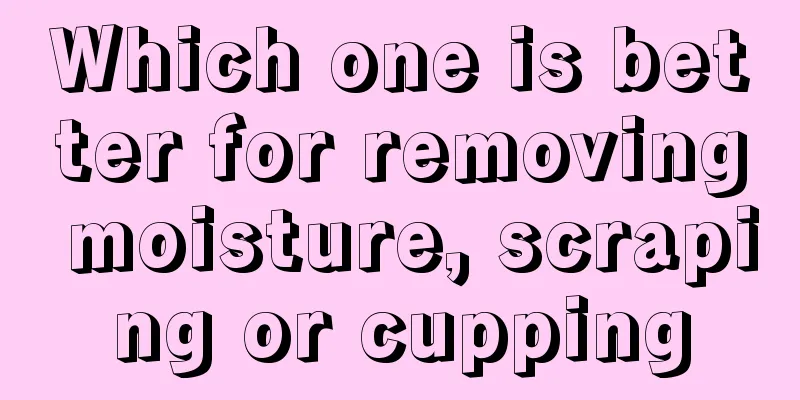Which one is better for removing moisture, scraping or cupping

|
Both scraping and cupping can remove moisture and relieve physical and mental fatigue, so it is appropriate to perform scraping or cupping in daily life. The most important purpose of cupping and scraping is not to remove dampness. Cupping is to expel dampness and toxins from the body, unblock stagnation, reduce swelling and relieve pain. Therefore, it is recommended that you understand the effects of scraping and cupping, and then choose the corresponding method. Which is better for removing moisture: scraping or cupping? Removing dampness is the popular understanding of the main function of cupping and scraping. Little do people know that this is a huge misunderstanding! The main function of these two traditional Chinese medicine therapies is not to remove dampness, and the effect of removing dampness is not obvious! Not only do people misunderstand cupping and scraping, they also like to talk about "heavy dampness". Physical fatigue, laziness, getting angry, and eczema are all classified as heavy dampness, but this is not necessarily the case. The purpose of cupping is not to remove dampness "Cupping can remove dampness and toxins, which is the biggest misunderstanding about this therapy." In Chinese medicine, the principle of cupping is: through the squeezing effect of physical negative pressure, blood vessels are caused to rupture and bleed, and blood penetrates into local tissues to unblock stagnation and achieve the effect of regulating the body's balance. Its main function is not to remove dampness, but to dredge the meridians and activate the collaterals, promote qi and blood circulation, reduce swelling and relieve pain, dispel wind and cold, and detoxify. Therefore, cupping is often used to treat diseases related to meridian blockage, such as irregular menstruation, neck, shoulder, waist and leg pain, etc. At the same time, cupping also has the function of "purging fire" and is often used to treat various solid diseases, including heat and cold. The purpose of scraping is not to remove dampness The principles of scraping and cupping are similar, and the same principle applies to "scraping out sha". Through treatment on meridians and acupoints, it has a good effect on fever, heatstroke, colds and other solid diseases, and can also effectively relieve heat symptoms such as getting angry. In comparison, scraping works on the shallow part, while cupping works on the deeper part; and scraping can only be used on people with solid diseases or fever symptoms. It is not recommended for the elderly, children, and the weak, and is prohibited for pregnant women. Eliminating dampness mainly relies on internal treatment Eliminating dampness mainly relies on internal treatment, first eliminating dampness and then regulating the spleen and stomach Many people think that cupping can quickly remove moisture, but in fact it cannot achieve the expected effect. "The essence of 'dampness' in traditional Chinese medicine is water." Dampness is mainly discharged through urine, feces and sweat. Although the main purpose of cupping and scraping is not to remove dampness, they do "draw" out some tissue fluid and have a certain effect in removing dampness. However, since not much water comes out, the dehumidifying effect is actually very limited. Cupping is relatively better, while scraping has almost no effect in removing dampness. "Eliminating dampness mainly relies on internal treatment rather than external treatment." Patients with heavy dampness must first identify the type of dampness, and then use diuretic drugs to relieve surface symptoms. Since the fundamental cause of heavy dampness is insufficient spleen and stomach function, after removing dampness, you also have to regulate the spleen and stomach to fundamentally improve your physical condition. "The darker the color of the sha pulled out or scraped, the heavier the dampness in the body!" Typical symptoms of dampness Thick white tongue coating, thick yellow tongue coating, sticky mouth, loss of appetite, indigestion, fatigue, muscle aches, sticky stools, etc. The darker and darker the cupping color, the heavier the moisture It's all legend! The color is related to blood and cupping strength! If the main function of cupping and scraping is not to remove dampness, then why is the color of the "sha" that comes out different, some darker, some lighter, some red, and some purple? It is actually very simple to explain. First of all, different people have different blood colors and skin colors, so the color of the "sha" that comes out will naturally be different. Secondly, the depth of the color of the sha is also related to the negative pressure of cupping. For example, in addition to fire cupping, Chinese medicine cupping also uses bamboo cups, vacuum cups, etc. Among them, bamboo cupping deoxygenates in water, which does not have the same temperature as fire cupping, and the exhaust pressure is relatively small. It is not only inconvenient to operate, but also not powerful enough, and the color of the sha tends to be lighter. |
<<: Can sweating more remove moisture?
>>: Does silver remove moisture?
Recommend
What harm does glacial acetic acid do to humans and what are the countermeasures?
Glacial acetic acid is widely used as a raw mater...
What is causing my lower back pain and leg numbness?
When symptoms of lower back pain and leg numbness...
What kind of meat is forbidden for colorectal cancer patients? Avoid eating pickled and smoked meats for colorectal cancer patients
Patients with colorectal cancer should avoid eati...
How to reverse arteriosclerosis?
Arteriosclerosis is a pathological change that is...
Lumbar disc herniation and leg weakness
In life, many of our friends will experience leg ...
What is the reason for eczema on the soles of feet
Eczema on the soles of the feet is mainly caused ...
Gum recession and enlarged gaps between teeth
In daily life, people usually do not pay attentio...
Preventing recurrence of bladder cancer after surgery
Bladder cancer is a type of cancer of the urinary...
A must-have for staying up late in high school
Students in their third year of high school often...
How to get rid of garlic smell from hands?
Garlic is something people often eat in their dai...
There are 4 treatments for bone cancer
Bone cancer is the most difficult disease to trea...
Symptoms of esophageal cancer at different stages
Perhaps people already know that the symptoms of ...
How to quit drinking
In China, many people make friends over wine, esp...
Does pig stomach nourish the kidneys?
Pork tripe is a relatively common food ingredient...
Which department should I go to for facial paralysis
After facial paralysis occurs, patients should se...









